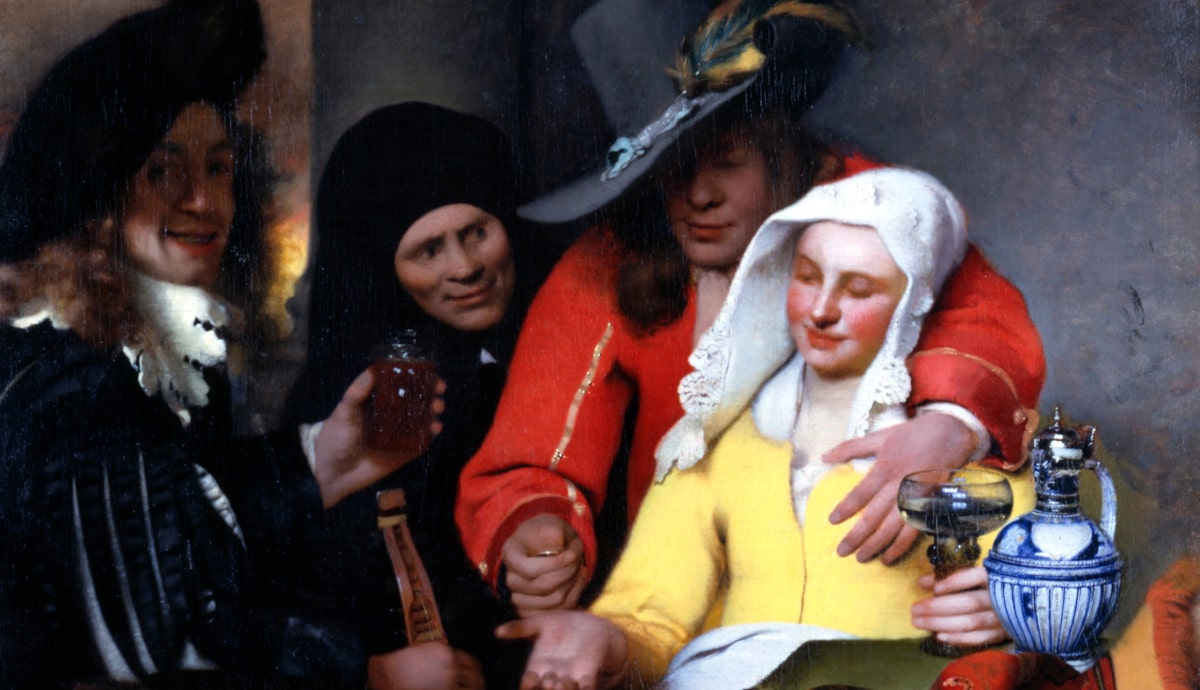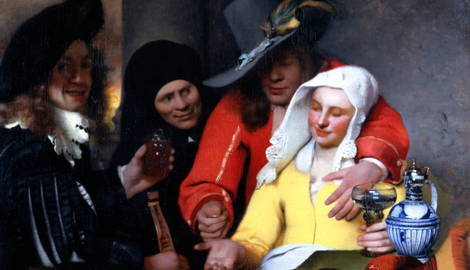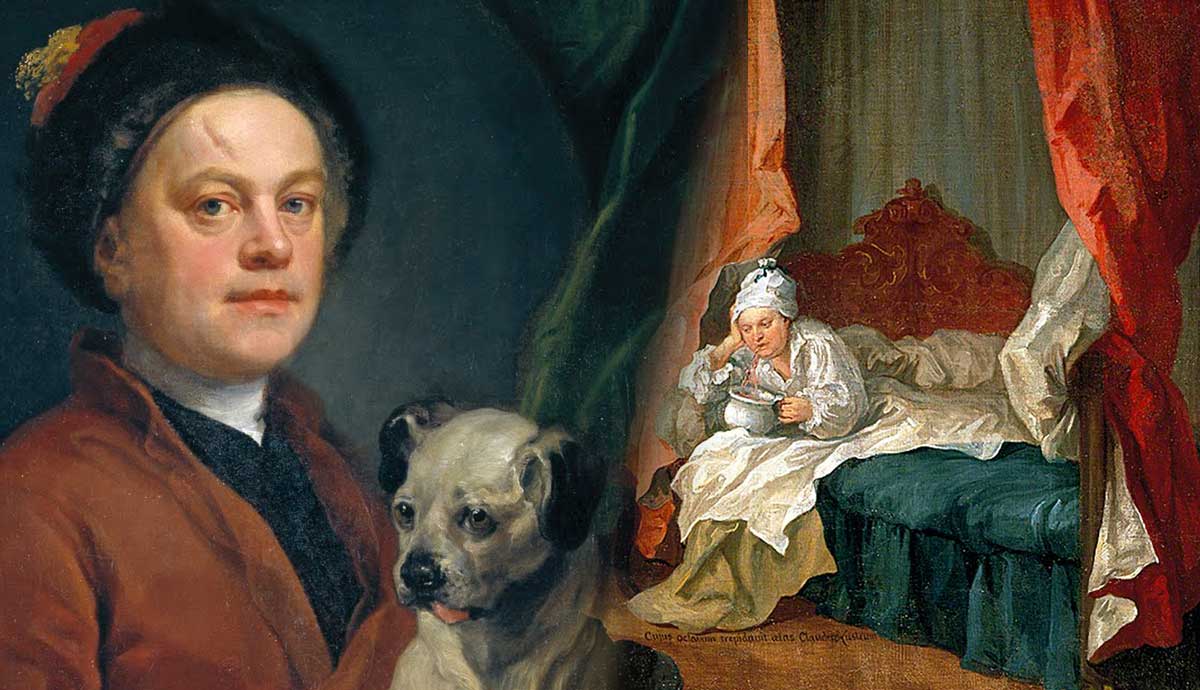
There is little to learn about Vermeer’s personal life, and that may be because very few interesting or exciting events happened to him. He seems to have devoted every hour to his work, and there are no records of any involvement in public affairs or office. Nonetheless, his paintings eventually came to have a momentous effect on the understanding of 17th-century art, and he is now considered an important artist in the Dutch canon.
10. Vermeer’s work was designed to reflect his immediate environment

Vermeer lived his whole life in the Netherlands, spending most of his years in the city of Delft, where he was born in 1632. It is here that the vast majority of his paintings are set, providing a glimpse into the quiet world of a small Dutch city.
Paintings and portraits were usually the domain of the wealthy and the elite, but since Vermeer did not come from a rich or noble family, his domestic scenes offer a rare glimpse into the world of the middle-class.
It is documented that shortly before Vermeer’s birth, his father had entered the art trade as a dealer in paintings. After his death, Vermeer took over the family firm at only 20 years of age, which must have equipped him with the contacts and connections that would prove important in his own career.
9. Vermeer’s aim was to replicate reality in his work

There are speculations about who taught Vermeer the art of painting, with scholars debating a range of possible tutors, with little evidence to support any of their stances. It is clear, however, that Vermeer was inspired by the contemporary Dutch movement known as The Fijnschilders, which literally means ‘The Fine-painters’. These artists aimed to reproduce reality in their meticulous, naturalistic and often small-scale paintings.
Although Vermeer is not recorded to have painted still-lifes – a favored genre within the movement – his portraits and scenes do still strive to capture the real, and even the ordinary, rather than embellishing or inventing. He may have been swayed by the huge sums of money for which Fijnschilder pieces were sold at the time.
8. As a result, Vermeer’s pieces are valuable sources of information about seventeenth-century life

The majority of Vermeer’s paintings convey two areas of life that were generally neglected by seventeenth-century artists: women and the home. In his extant oeuvre, female figures appear around 40 times, while males only 14. Many of Vermeer’s scenes center around domestic life: it is even believed that the interiors are based on rooms in his own house and the subjects modeled on his family and servants.
The women that appear in Vermeer’s work are not the typical beauties that appear in the Italian paintings produced at this time, and nor are they so scantily clad. Instead, they are realistic, homely women whose appeal derives from the warm, inviting, and safe environment in which they are presented.
7. And yet, Vermeer’s portrayal of women also mirrors important social developments of the time

In the 17th century, the Netherlands was experiencing not only a Golden Age of art, but also of exploration, as Dutch seafarers explored further and further afield, often flying the flag of the prolific East India Company. This expansion gave rise to increased commercialization, as trade became the epicenter of Dutch life. This meant that people who had not necessarily been born with wealth and status could achieve it, and thus arose the middle-class.
As a result, there was a growing interest in the domain of the house, which had been transformed from a private area into a public arena of display. This had a profound effect on women, who appear more and more frequently in paintings of household scenes. Vermeer’s women represent this new interest in the domestic, and also exhibit a sense of personality not typically portrayed before. The artist understands the psychology of the female portrait, and therefore many of his subjects have novel and expressive faces. This marks one of the first times in Dutch art where the female was the focus for her own sake.
6. Likewise, his most famous masterpiece conceals a wealth of subtle information

This Girl with a Pearl Earring, created in the middle of Vermeer’s career, stores a wealth of information in its symbols and style. Pearls were an important sign of status in the 17th century: 11 of Vermeer’s women wear pearls, and critics have even noted an opalescent sheen to their faces, created by his silvery palette and the texture of his oils. Pearls held a lure of exoticism, also captured by the model’s turban, representing the new Dutch exploits in the east and the untold wealth they hoped to find there.
The painting may also help to make connections between European art at the time. Scholars have proposed that The Girl with a Pearl Earring is based on a portrait by Italian artist, Guido Reni. There are visible similarities, and Vermeer may have seen a copy or an engraving of Reni’s work. This connection helps to illuminate the interconnected nature of European art at the time, with reproductions of influential pieces circulating across the continent.
5. Vermeer’s interiors are often as interesting as the people within them

It would have been rare, in Vermeer’s time, to enter into somebody’s private rooms and even more uncommon to see them represented in art. It was usual for people of certain means, especially those wealthy and important enough to have paintings made of them, to have reception rooms specifically designed to receive visitors. Vermeer’s depiction of household interiors, therefore, allows for a voyeuristic glimpse into the largely unseen world of the kitchen or the bedroom. All sorts of intimate information can be inferred from his scenes, from the instruments of a lady’s toilette, to the socially acceptable occasions for drinking.
Another striking feature of Vermeer’s interiors are the maps that so often appear on the walls. The Netherlands was the center of seventeenth-century cartography, with important mapmakers working out of the major cities and the expansion of the East and West India Companies calling for new and updated navigation material. Maps and charts therefore became more common possessions, and their appearance in Vermeer’s paintings help to illuminate how the cartographical boom was felt at all levels of society. In fact, the same map of the Low Countries appears in three of Vermeer’s paintings, suggesting that he may have owned it himself.
4. Vermeer’s paintings are not just single snapshots, but dynamic stories

Despite being inspired by the Fijnschilders, whose style can be described as static, Vermeer was able to inject a sense of dynamism into his paintings. His brushstrokes often leave his subjects slightly blurred, creating the illusion of movement. Similarly, he often animates figures by showing them in the midst of an activity rather than in a rigid posture.
Vermeer was even known to reconfigure his paintings part-way through, changing the angle of a certain body part, which has the added effect of simulating movement. His use of light, particularly glancing sunlight, also helps to capture a vibrant energy.
3. Vermeer’s use of color was particularly effective in creating vivid paintings

Vermeer utilized the entire color spectrum in his paintings. The earthy hues of ochre and umber are offset by the rich and bold tone of lapis lazuli, the artist’s favored pigment. He used the expensive color lavishly and to great effect, as displayed in The Girl with the Wine Glass.
Although it appears completely red, Vermeer painted a layer of lapis lazuli as the base, giving the material a bright sheen. Vermeer’s technical understanding reflects that of the Old Masters of the Italian Renaissance, particularly the observation that objects take on the tones of the things around them.
2. Although his paintings sold for a much higher price than average, Vermeer was far from financially successful

After Vermeer’s death in 1675, his wife and 11 children were left saddled with piles of debt. His wife attributed her late husband’s demise to a mixture of stress, depression and frenzy, all brought on by financial difficulties. She blamed the ongoing war between the Netherlands and France, claiming that the tumultuous political climate made it impossible for her late-husband to sell any of his own art, or broker anybody else’s.
Although he had won a good reputation, Vermeer had never been a prolific painter, and the few pieces he did produce were largely purchased by a single collector, Peter van Riujven. This prevented demand from increasing enough to boost the value of his work. His preference for rich, and therefore expensive, colors probably didn’t help his financial situation either.
1. Although he never strayed far from home, Vermeer’s renown eventually spread across the world

In the immediate aftermath of his death, Vermeer was mourned but not celebrated. He had never had pupils, so there was nobody to continue his workshop and his artistic legacy. Over one hundred years later, however, his work was rediscovered by two important art historians and critics. They published several articles about the masterpieces of Vermeer, and from that time onwards his reputation has grown and he has at last been awarded his deserved place in the canon of Dutch art.










